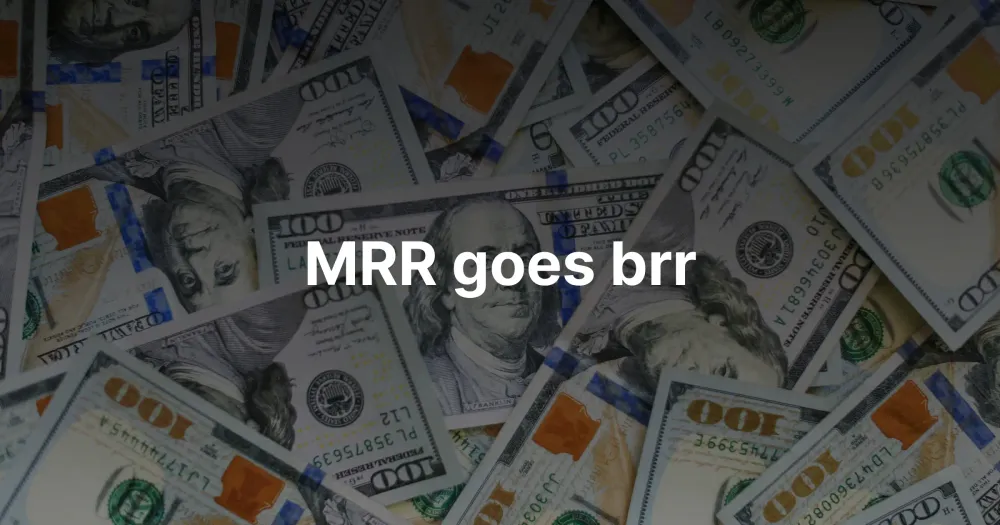So, it happened. Magic Pages just hit the $1,000 MRR milestone! Or, for those of you who haven't been indoctrinated by the Twitter hustle culture: $1,000 in Monthly Recurring Revenue.
Naturally, I should be popping champagne and plastering this achievement all over social media. But instead of milking this (literal?) cash cow and shouting from the digital rooftops, I want to take a moment to show you why this milestone isn't as significant as it's seems to be. Spoiler alert: MRR is just a fancy metric from business books—not the real world.

First things first, what does it even mean?
Well, in the world of software-as-a-service businesses, montly recurring revenue is kinda like a key metric. It tells you how much money comes in every month (or does it?). In fact, it's an even better metric to use for your Twitter feeds to show people how immensely cool you are. Research also shows that it works equally well on Threads, as of recently.
Okay, enough with the sarcasm.
Quite honestly, the significance of MRR is pretty inflated, in my eyes. Especially the way most businesses structure their subscription plans.
Let's take Magic Pages as an example. As of today, the MRR stands at a whopping $1,034. Cue the confetti! But wait... the actual money hitting the bank each month is quite a bit more than that.
Confused yet? Hold my calculator.

MRR is a highly theoretical number. Payment processors typically take your yearly subscription revenue and divide it by 12 to calculate MRR. Sounds neat, but reality isn't so tidy.
Let's say in September, I sell:
- 10 monthly subscriptions at $10 each
- 2 yearly subscriptions at $100 each
Over a year, if nothing changes:
- Monthly subscriptions: $10 x 12 months x 10 people = $1,200
- Yearly subscriptions: $100 x 2 = $200
- Total yearly revenue: $1,400
- MRR: $1,400 ÷ 12 = $116.67
But hold up. The actual revenue in September was:
- Monthly subscriptions: $10 x 10 = $100
- Yearly subscriptions: $100 x 2 = $200
- Total September revenue: $300
In October, if no new sales occur:
- Monthly subscription renew: $10 x 10 = $100
- Yearly subscriptions: $0 (they won't renew until next September)
- Total October revenue: $100
Neither of these numbers match the theoretical $116.67 MRR. See the disconnect?
And that's the problem with MRR. For real-life business planning, it's about as useful as a chocolate teapot. Sure, it looks delicious, but it melts under heat.
As an entrepreneur, what you truly want to know is your cash flow. The actual amount of money that comes in every month.
Practically speaking, there are two parts to your cash flow: the plannable and the unplannable (though that may be oversimplifying things a little).
- Plannable Cash Flow: Predictable income like monthly subscriptions.
- Unplannable Cash Flow: This includes yearly subscriptions, one-time purchases, extra charges, and anything else that's just not regular (yet).
For Magic Pages, the monthly cash flow is significantly higher than the MRR because of these additional revenue streams.
Here's another plot twist: Revenue ≠ Profit.

If someone tells you their SaaS is raking in $10k MRR, ask them how much of that is actually profit. Watch as they try to come up with an answer.
Running a business costs money. Servers, domains, software, marketing, etc. And while SaaS businesses often have higher profit margins compared to traditional businesses, you can't run your SaaS on dreams and fairy dust.
My Financial Strategy for Magic Pages
For Magic Pages, I've set a simple rule:
- 50% of predictable cash flow goes toward operational costs (infrastructure, subscriptions, etc.).
- 50% goes into a cash reserve for the business.
This means every month, I'm effectively buying an additional month of runway—even if all my customers decided to cancel tomorrow.
As for the unplannable cash flow, I mostly reinvest that into the business, right now. Recently, I've set up a robust backup solution and upgraded my home office (hello, wall panels and shiny new camera). There might be some video content coming soon—stay tuned! 👀
In the long term, I am trying to make the unplannable cash flow a bit more...well, plannable. By March 2025, after a full year of running Magic Pages on a subscription basis, I'll have a clearer picture of yearly subscription.
I'm also thinking about the future of lifetime plans. Not because they're unprofitable—they're actually great—but their revenue unpredictability is like a rollercoaster. And that is not ideal for financial planning.
So, there you have it. MRR goes brr—and yet, it means next to nothing 😂
The next time you see someone showing off their MRR milestones on social media, take it with a grain of salt. Remember, MRR is just one piece of a much larger puzzle.
And yes, this will be the only post I'll share about Magic Pages' MRR 😉
But hey, I'm curious: If you're also running a SaaS business, what's your experience with metrics like MRR? Do you find cash flow to be a better indicator of your business's health? Or is there another metric you swear by?
